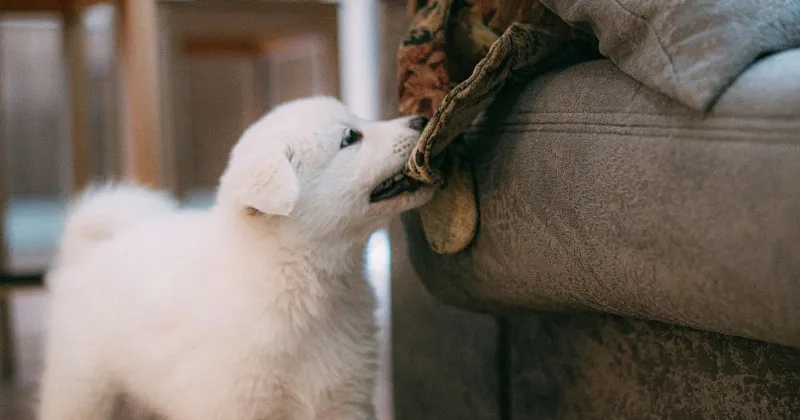Puppies naturally engage in nipping and biting as part of their development, often due to teething, excitement, hunger, the need to potty, fatigue, or even minor tummy discomfort. Puppy nipping is a common challenge for new dog owners, but understanding the reasons behind it is key to addressing it effectively. Always start by consulting your veterinarian to rule out any underlying health issues before diving into training. Observing your puppy’s body language right before a nip—such as a wiggly, playful stance or a stiff posture with a high tail—can reveal triggers like play invitations learned from littermates.
For related puppy behavior issues, check out our guide on dog wont stop scratching door. Positive reinforcement through clicker training, combined with smart management, helps puppies learn appropriate boundaries without fear or punishment. This approach builds trust and turns nipping into polite play, making interactions safer and more enjoyable for everyone.
Management Tips to Prevent Puppy Nipping
The foundation for stopping puppy nipping lies in proactive management and operant conditioning. Puppies don’t intend to hurt, but their sharp teeth can sting, so prevention is crucial during this normal developmental phase.
Keep puppy-safe toys or chews handy during play, petting, or interaction. If your puppy grabs your hand or clothing, freeze your movement immediately—motion fuels their play drive. Redirect gently by offering a toy instead, like a frozen carrot slice simmered in dog-safe bone broth, a durable puppy chew, or a sock stuffed with a tennis ball. Designate a safe space, such as an exercise pen with bedding and toys or a baby-gated area, for short timeouts when supervision lapses.
While scratching your puppy’s belly or back, provide a chew toy to mouth—this teaches them what’s acceptable. Many puppies soon grab a toy first as a “rules reminder,” earning pets as reinforcement. These strategies reduce opportunities for nipping while promoting good habits.
 A playful puppy nipping at a hand during training
A playful puppy nipping at a hand during training
Reinforce Calm Behaviors Before Nipping Escalates
Overlooking precursors to puppy nipping is a frequent oversight. Puppies might calmly station near you before escalating to bites for food or play. Counter this by feeding or rewarding stationary, relaxed postures preemptively.
Practice “stationing,” where your puppy stands calmly in front of you. Use high-value treats to click and reward this behavior, making it more likely than nipping. For instance, if your puppy lingers quietly, deliver a meal or toy right away. This shifts their focus from demanding bites to polite waiting, preventing frustration-driven mouthing.
Experienced trainers note that consistent reinforcement of calm states early on dramatically cuts nipping incidents. According to the American Kennel Club (AKC), proactive positive reinforcement strengthens desired behaviors over time.
Training “Open Your Mouth” for Quick Releases
Clicker training shines in teaching puppies to release on cue, turning potential conflicts into learning moments. Start with tiny treats like pea-sized cheese or chicken bits (or meat baby food on a chopstick for small breeds with needle-sharp teeth).
Click and treat 2-3 times just for approaching you. Offer a tempting toy or cloth; click when they grab it, then present a treat. Click again upon release for the treat. Avoid clicking for grabbing forbidden items. Repeat until they drop eagerly on the click sound.
Add the verbal cue “Open” right before clicking. Progress to saying “Open,” pausing, and waiting for voluntary release—click and treat precisely then. Practice daily until they respond promptly. Keep clicker and dry treats accessible; if nipping occurs, freeze, cue “Open,” and reward lavishly. Family-wide consistency amplifies success.
Keep dry treats and clickers handy whenever the puppy is loose in the room.
This method, rooted in operant conditioning pioneered by experts like Karen Pryor, empowers puppies to self-regulate without force.
Master “Close Your Mouth” for Safer Interactions
Complement release training by shaping mouth closure. Watch for natural moments when your puppy shuts their mouth—click and treat immediately. Repeat opportunistically to build the behavior.
Introduce the cue “Close mouth” just before withdrawing your hands, then click and reward closure. Once reliable, teach household members this cue for grooming or play. For the puppy, it’s a fun “clicker game,” not discipline, fostering safety and confidence.
Veterinarians and certified trainers, including those from the Certification Council for Professional Dog Trainers (CCPDT), endorse these techniques for their gentleness and efficacy, especially avoiding hand-associated fear during brushing or exams.
For more on common dog behavior problems pooping in house, explore our resources.
Final Thoughts on Ending Puppy Nipping
Stopping puppy nipping requires patience, observation, and consistent clicker training. By managing environments, reinforcing calm alternatives, and teaching cues like “Open” and “Close mouth,” you’ll guide your puppy toward gentle interactions. Most puppies outgrow intense nipping by 6-8 months with this approach, but persistence pays off.
Consult your vet for personalized advice, especially if nipping persists unusually. Ready for more? Dive into our dog training articles for tips on everything from basic obedience to advanced behaviors.
References
- American Kennel Club (AKC): Puppy Training Basics (akc.org)
- Karen Pryor Clicker Training: Positive Reinforcement Principles (clickertraining.com)
- Certification Council for Professional Dog Trainers (CCPDT): Guidelines for Puppy Behavior (ccpdt.org)
Originally inspired by clickertraining.com content, updated for modern best practices as of 2024.
